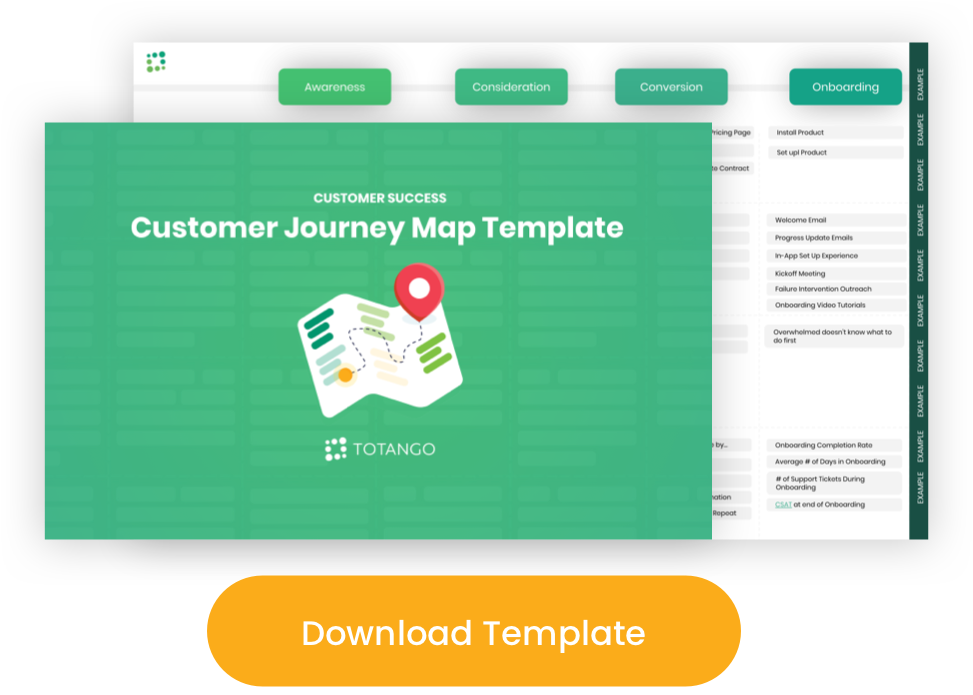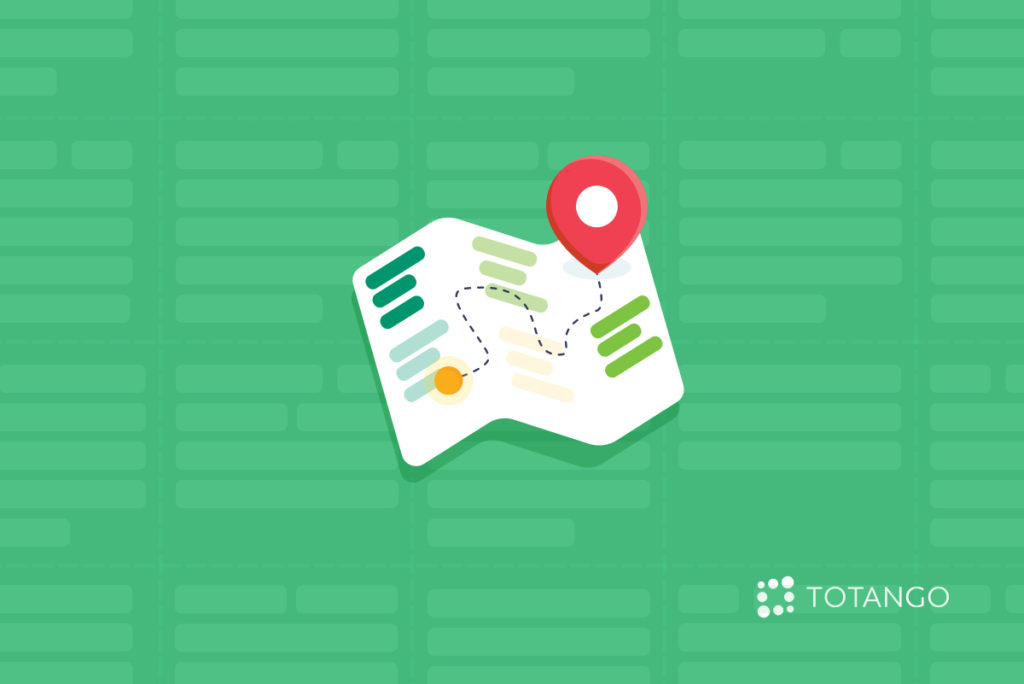 A customer journey map template lays out a path to optimal outcomes promoting client retention. Here we’ll cover an eight-step approach to creating a customer journey map that encompasses all stages of your customers’ experience, including pre-sales and post-sales experiences. We’ll also provide a customer journey map template you can adopt and adapt to optimize your customers’ experience and increase client retention.
A customer journey map template lays out a path to optimal outcomes promoting client retention. Here we’ll cover an eight-step approach to creating a customer journey map that encompasses all stages of your customers’ experience, including pre-sales and post-sales experiences. We’ll also provide a customer journey map template you can adopt and adapt to optimize your customers’ experience and increase client retention.
Mapping the Modern Customer Journey
In the SaaS industry and in other industries borrowing its insights, the modern customer journey has been reconceived from a more customer-centric perspective. The traditional customer journey had previously been viewed from the perspective of the seller. From this vantage, the customer journey divides into a pre-sales buyer’s journey, which is driven by marketing and sales, and a post-sales customer journey, which is the responsibility of customer success teams and account managers. In this context, customer journey maps are typically visualized as funnels focused on the path to purchase, with less emphasis on the post-sales journey.
But from the customer’s perspective, the experience of your brand includes both the pre-sales and post-sales experience. A customer’s entire experience of your brand influences whether they choose to become repeat buyers promoting your products to others or lost customers negatively impacting your reputation. From this unified, customer-oriented perspective, the complete customer journey is a cyclical process, where customer satisfaction promotes repeat business and referrals which generate more business. This makes the modern customer journey look more like a flywheel than a funnel.
Moreover, the modern customer journey is fluid, with customers often engaging in multiple stages of the process simultaneously rather than following a single sequence. For instance, a customer may already be considering whether or not to buy an upsell SaaS product even when they’re still in the process of adopting their first purchase so that their experience of their initial purchase influences their perception of their prospective purchase. The modern customer journey includes all experiences which inform a customer’s total experience of your brand, whether or not they occur in a preconceived sequence.
From the flywheel perspective, the customer journey includes both the pre-sales and post-sales phases of the process. For planning purposes, this can be broken down into eight steps:
- Awareness: a prospect encounters your brand in your marketing space
- Consideration: the prospect engages with your brand on your website
- Conversion: the prospect makes a purchase and becomes a customer
- Onboarding: your new customer takes preliminary post-purchase steps, such as setting up a username and password
- Adoption: customer usage of your product
- Renewal: your customer renews their subscription or license and becomes a repeat buyer
- Expansion and growth: your customer’s increased engagement with your brand leads to cross-sell and upsell opportunities
- Loyalty and advocacy: satisfaction with your brand inspires your customer to promote you to others
To optimize each stage of this journey, it’s important to focus on metrics that can help you set goals for customer experience, measure success, and take data-driven actions. Let’s look at some ways you can use key performance indicators at each stage to flesh out your customer journey map template and translate it into action.
1. Awareness
In the awareness stage, you can track your prospective customer’s journey through metrics reflecting their encounter with your brand through digital channels, including:
- Organic search engine marketing
- Paid search advertising
- Social media
Data from these sources can provide you with important insights, such as where prospects are finding your brand, what search terms they’re using and what pain points led them to seek you out. Knowing this can help you prequalify prospects and focus your marketing efforts.
2. Consideration
In the consideration stage, relevant metrics track prospects’ digital engagement with your brand, such as:
- Unique visitors
- New vs. returning visitors
- Scroll depth
- Time on page
- Bounce rate
- Exit pages
- Email newsletter subscriptions
- Free trial subscriptions
- Free trial product usage
- View pricing page
This type of data can provide insight into what customers are doing on your website and how you could steer them more effectively towards pages and actions which set the stage for sales.
3. Conversion
In the conversion stage, the most important metrics are sales conversions and sales revenue. You can segment this by a number of variables, such as:
- Product
- Referring source
- Prequalifying information
- First-time buyers vs. repeat buyers
Analyzing your conversion data can deepen your understanding of important sales information such as who your buyers are, where they’re coming from, and what they’re buying. Knowing this can help you gauge the effectiveness of your sales process and make adjustments and improvements. For example, you can use Totango Spark’s Freemium SuccessBLOC module to automate actions that promote higher conversions from freemium trials to paying customers.
4. Onboarding
Tracking the onboarding stage is important to make sure new buyers are progressing toward becoming active users. You can track this through KPIs such as:
- Onboarding completion rate
- Average number of days in onboarding
- Number of support tickets during onboarding
- Customer satisfaction score (CSAT) at end of onboarding
Use this type of data to ensure that your customers are completing onboarding, identify snags in your onboarding process, and take steps to remove barriers to successful onboarding. For example, you can use Totango’s Onboarding SuccessBLOC to automate onboarding tasks and trigger early warning alerts when customers get behind the curve.
5. Adoption
Monitoring the adoption stage helps you track user activity levels to make sure buyers are on a path to renewal. Important metrics to track include:
- License utilization
- Customers who have either increased or decreased usage
- Feature adoption
- CSAT after adoption
- Achievement of desired customer adoption outcomes
- Product stickiness
This type of data can help you evaluate the success of your adoption procedures and intervene with customers who are showing low adoption levels. The Increase Customer Adoption SuccessBLOC tracks usage and adoption and helps you get users back on track when adoption dips.
6. Renewal
The renewal stage represents a critical point in your customer journey, determining whether or not they become repeat customers and brand advocates. Important data to monitor include:
- Customer health score, a consolidated, simplified overview of multiple metrics indicating a customer’s likelihood of renewal or risk of churn
- Renewal rate
- On-time renewal rate
- At-risk customers
It’s important for account managers to review this type of data for individual customers as renewal approaches. Many customers make the decision whether or not to renew as much as six months before their subscription expires.
7. Expansion and Growth
In the expansion and growth phase, customers increase their engagement with previous purchases and consider making additional purchases. Metrics you can track include:
- Visits to web pages providing tips on advanced features
- Advanced feature adoption rate
- Support tickets involving advanced features
- Cross-sell and upsell purchases
- Conversion rates for cross-sell and upsell offers
- Customer lifetime value
- Free trial sign-ups from word of mouth marketing
These types of numbers can help you track engagement among your existing customers and take steps to promote higher revenue from repeat business.
8. Loyalty and Advocacy
The loyalty and advocacy phase represents the climax of your customer journey map, indicating how likely customers are to remain buyers and promote you to others. Key metrics include:
- Customer retention rate
- Customer churn rate
- CSAT
- Net Promoter Score (NPS)
- Referral rate
- Referral revenue
This type of data helps you evaluate the overall effectiveness of your customer journey strategy at promoting customer retention and referrals. Correlating this data with data from earlier phases in your customer journey can help you identify places where your customer journey strategy needs adjustment and improvement. For instance, low retention rates coupled with low onboarding rates may indicate a need to improve your onboarding process.
Automate Your Customer Journey Map Template to Chart Your Path to Success
The modern approach to customer journey mapping replaces the emphasis on the pre-sales funnel with a fluid journey representing the complete customer experience, including everything from pre-sales brand awareness to post-purchase brand advocacy. A strategic approach to customer journey mapping seeks to optimize each step in the process by using measurable KPIs to ground data-driven actions promoting customer retention.
The Totango Spark platform supports modern customer journey mapping by providing SuccessBLOC modules with all the KPIs and tools you need to optimize each stage of your customer’s journey. Try it free to see for yourself how Spark can help you promote better customer journeys and higher client retention.

